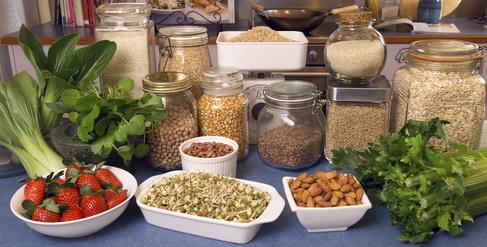A child with attention deficit hyperactivity disorder may fidget uncontrollably, get up from his seat during class or be unable to pay attention to assignments and instructions. There are several treatment options for children with ADHD, according to the Mayo Clinic. If your child has ADHD, you can try to treat his condition with medication or therapy. Some evidence suggests that eating certain foods and avoiding others can help control and treat ADHD.
A child with attention deficit hyperactivity disorder may fidget uncontrollably, get up from his seat during class or be unable to pay attention to assignments and instructions. There are several treatment options for children with ADHD, according to the Mayo Clinic. If your child has ADHD, you can try to treat his condition with medication or therapy. Some evidence suggests that eating certain foods and avoiding others can help control and treat ADHD.
Types
A diet to treat your child's ADHD should be rich in whole, unprocessed foods. The Mayo Clinic recommends that you feed your child plenty of fruits and vegetables, whole grains and foods rich in Omega-3 fatty acids. According to the University of Maryland Medical Center, some children with ADHD have lower levels of eicosapentaenoic acid and docosahexaenoic acid in their brains than children who do not have the illness. Some studies suggest that foods high in omega-3 are useful for treating ADHD. Foods containing magnesium and vitamin B-6 as well as high-protein foods may also help treat ADHD.
Considerations
According to ADDitude magazine, children with ADHD are often able to pay attention better if they consume an adequate amount of protein in their diet and eat a breakfast high in protein. Eating foods that contain plenty of protein, such as fish, beans or eggs, activates neurotransmitters that help people stay alert. If your child has ADHD, try giving him a boost of protein first thing in the morning. A diet high in magnesium may also help control ADHD symptoms, according to the University of Michigan. Nuts such as cashews and almonds are a good source of magnesium.
Theories/Speculation
In the 1970s, Benjamin Feingold, a doctor from Kaiser Foundation Hospital in California, put forth the idea that foods that contain additives, such as dyes and flavorings, can trigger ADHD and hyperactive behavior in some children. According to the Mayo Clinic, recent studies back up Feingold's theory that additives can trigger hyperactivity. You may want to eliminate foods that contain Yellow No. 5, Yellow No. 6, Yellow No. 10 and sodium benzoate from your child's diet.
Time Frame
If you decide to use diet to treat your child's ADHD, the Center for Science in the Public Interest recommends that you allow about three weeks for the diet to take effect before determining whether it is working. Record any incidences of hyperactivity, inattention or other misbehaviors your child displays during the initial three-week period, as well as what foods he ate each day. If you notice changes in your child's behavior at the end of the trial period, try adding back in eliminated foods to see whether they trigger symptoms.
Warning
Consult your child's doctor or a nutritionist before making substantial changes to his diet. If you plan to put your child on a very restricted diet, you need to make sure he is getting enough needed vitamins, minerals and other nutrients, according to the Mayo Clinic. You may also find that treating your child's ADHD with diet alone is not effective. If so, talk with a doctor about other possible treatments, such as therapy.
Photo Credit
- healthy foods image by Steve Lovegrove from Fotolia.com





